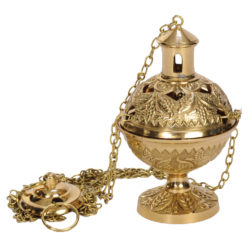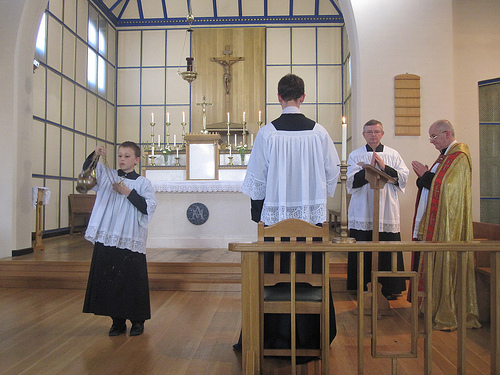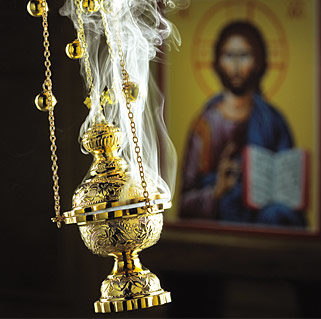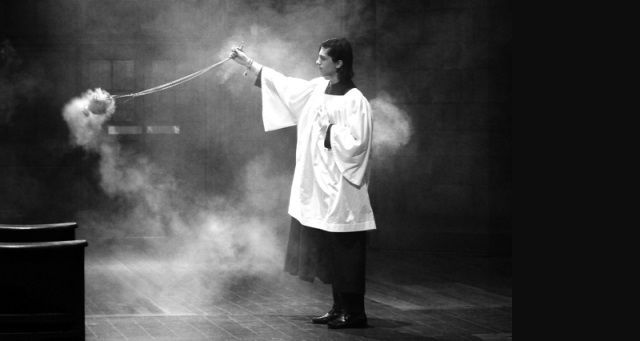Thuribles are ritual symbols of the Christian Religion
Thuribles have always been a part of worship services of the different Christian religions such as Lutheran, Roman Catholic, United Methodist, Oriental Orthodox, United Methodist, and more.

Thurible
What are Thuribles?
The term may not be familiar to most, yet, a common sight in every church service. The thurible is the metal container that emits smoke from the incense burned inside. It is suspended on chains which the altar server dexterously swings at certain times during the church service. The altar server is called the thurifertaken from the word thurible.
The ecclesiastical practice of using thuribles dates back to the religious practices of Judaism during the time of the Second Jewish Temple. The term “thurible” was taken from the word thurible from the Old French that has its roots in turibulum from Latin meaning incense.
In today’s setting, the term thurible has been changed to “incense burner” or simply, “boat”.
How does a thurible work?
A thurifer working a thurible during worship service looks simple, but it is not. Every thurible has a center to hold the burning incense, which in turn is suspended by three or four chains. There are designs for single-chain thuribles which are fairly uncommon. Around the chains is a metal ring to lock the center of the censer. There is usually a removable crucible in the center to put in the burning charcoals. Thuribles have stands to safely suspend it when not in use.
The metal censer or the boat holding the burning charcoal can either be removable or permanent. The loose incense sprinkled on top of the hot charcoal emits the smoke used for sensing sacred objects, the priests, and the people. While incenses come in different varieties, the sweet-smelling ones are commonly used in worship services.
 Why are thuribles used in worship?
Why are thuribles used in worship?
The sole purpose of a thurible in church services is to waft out smoke from the burning incense. If this is the only purpose of thuribles, what makes them so important to worship services?
The burning of incense in places of worship symbolizes prayer, offering, and the acknowledgement of the presence of God. The rising smoke coming from the thuribles symbolizes prayers offered by the faithful to send up to God. God’s presence in the worship service is magnified, almost to be physically felt by the worshipers because of the sweet smells emitted from the thurible.
Burning incense at the altar is the most crucial, the hardest job, and the sole responsibility of the thurifer. The thurifer has to keep the coals burning throughout the service while being dexterous every time he wafts out the smoke to prevent accidentally burning the priest and himself.
Opening and closing the thurible is not as simple as it looks where oftentimes, only one hand is used without tangling the chains. Setting the pace from beginning to end of the worship service together with the sequencing of sacred objects to be censed, is an art by itself that takes long practice on the part of the server or thurifer before it can be perfected.
 The sequence of censing
The sequence of censing
The start of every worship service begins with the thurifer censing the altar before moving over to the Gospel Book. The next cense time occurs after the proclamation of the Gospel.
The thurifer also cense special gifts offered at the altar right after censing the altar and the cross. During the Eucharistic prayer, all the servers, people, the choir, and the priests or ministers are censed.
As soon as the body and blood of Christ is consecrated during the Eucharistic prayer, the thurifer cense the consecrated wine and bread. The sequence of censing always follows a set pattern.
Censing sacred objects and people involved in the worship service vary, but follow a set sequence. The book of Gospels, the celebrant minister or priest, the co-celebrant priests or ministers, the altar and the cross each receive three double censing. During the Lenten season, a Paschal candle lighted on the platform of the church also receives three double censing.
The deacon and non-celebrant ministers and priests are given two double censing while one double censing goes to the congregation, sub-deacons, choir, and altar servers.
Placing and blessing the incense in the thurible
At every Sunday worship service, the first incense blessing takes place in the vestry where the hot coals in the center of the thurible are sprinkled with loose incense by the celebrant priest. The traditional ritual followed is for the thurifer to present the thurible to the priest or minister speaking the words, “Pray Father a blessing”.
This gives the signal for the officiating priest to sprinkle the incense grains on top of the burning coals before speaking the words, “Be blessed by Him in whose honor you shall be burned”, followed by the sign of the cross. This is the sign for the thurifer to close the lid of the thurible.
The second incense blessing takes place before the Gospel procession where the thurifer approaches the celebrant priest at his chair. The same ritual and blessing that first happened in the vestry is repeated.
The third and last incense blessing happens before the Eucharistic prayer. The thurifer, holding the thurible again approaches the celebrant priest at his chair to request for the final blessing. The slight variation to the ritual is with the prayer offered by the celebrant priest that will be, “At the intercession of the Blessed Michael the Archangel who stands at the right hand of the altar of incense, may the Lord graciously accept this fragrant offering to His praise and glory”.
The symbolism and tradition of thuribles
The tradition of using thuribles during Sunday Mass or any worship service represents an important symbol to every Christian believer. The role of the thurible may only be a vessel, yet it is a worthy vessel created to hold one of the most important essences in a Sunday church worship. The perfumed sweetness of incense emanating from the thurible evokes and inspires a deeper spiritual experience between man and his Creator.

